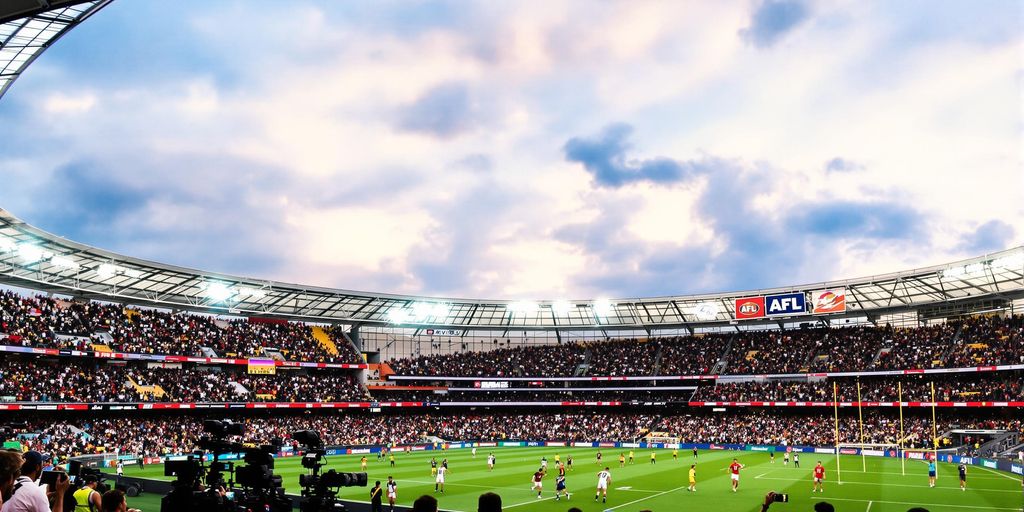Significance Of The AFL TV Rights 2024 Deal

Impact On The AFL’s Financial Stability
The 2024 AFL TV rights deal is a massive win for the league, setting it up for long-term financial health. This deal injects a huge amount of money into the AFL, allowing for better resource allocation across all areas of the sport. It’s not just about the top level; this financial boost trickles down, supporting grassroots programmes and ensuring the league’s continued growth. The financial security provided by this deal allows the AFL to invest in infrastructure, player development, and community engagement initiatives, solidifying its position as Australia’s premier sporting code.
Comparison With Previous Broadcast Deals
This new agreement dwarfs previous deals, showcasing the increasing value placed on AFL broadcasting rights. To put it in perspective:
- The current deal averages $643 million a season.
- This is a significant jump from the previous $473 million per season.
- The increase reflects the growing popularity of the AFL and the intense competition among broadcasters.
The sheer size of this deal underscores the AFL’s dominance in the Australian sporting landscape. It’s a testament to the league’s ability to attract viewers and generate revenue, ensuring its continued success in a competitive market.
Long-Term Implications For The League
The long-term implications of the 2024 AFL TV rights deal are far-reaching. It provides the AFL with the stability to plan for the future, invest in innovation, and expand its reach. This deal allows the AFL to:
- Enhance the fan experience through improved broadcasting quality and digital platforms.
- Support the growth of AFLW, ensuring its long-term sustainability.
- Invest in grassroots football, nurturing the next generation of talent.
This deal isn’t just about the money; it’s about securing the AFL’s future and ensuring its continued success for years to come. It allows the AFL to continue to work with Tradable Bits to improve fan engagement.
Key Features Of The New Broadcast Agreement
Duration And Financial Terms
The new AFL broadcast agreement is a big one, running for seven years, from 2025 through to 2031. The total value is around $4.5 billion, making it the biggest sports broadcast rights deal in Australian history. Financially, this deal means the AFL gets about $643 million each season, which is a fair bit more than the $473 million they were getting under the previous arrangement. This increase gives the league a lot more financial stability for future planning.
Free-To-Air And Subscription Coverage
Seven Network is still in the mix, keeping the free-to-air TV rights. This means you’ll still be able to catch some games without needing a subscription. Fox Footy will continue their comprehensive coverage, so if you’re a subscriber, you won’t miss a thing. The split between free-to-air and subscription ensures a balance, catering to both casual viewers and die-hard fans. It’s good to know there’s something for everyone.
Digital Streaming Rights
Telstra is holding onto the digital rights, which means they’ll keep delivering every game live through the AFL Live App. This is great news for fans who like to watch games on the go. They’ve got the rights for all handheld devices, the club digital network, IPTV, and the AFL website. So, whether you’re on your phone, tablet, or computer, you’ll be able to stream the games live.
This continued partnership with Telstra is a smart move, ensuring that the AFL stays relevant in a world where more and more people are streaming content. It also allows for more interactive viewing experiences, which can really boost fan engagement.
What Fans Can Expect From The 2024 Season
Changes To Game Scheduling
Okay, so what’s changing with the footy schedule next year? Well, it looks like we’re sticking with a pretty similar format to what we’ve seen recently, which is good news if you’re not a fan of constant surprises. There’s talk about keeping the Thursday night games for the first 15 rounds, which is great for those mid-week footy fixes. I reckon we’ll see a fair few Sunday games early on, too. Hopefully, they spread the love and give all the teams a decent run in prime time. It’s all about balance, right?
Enhanced Viewing Options
Get ready to settle in, because the viewing experience is getting a bit of a spruce-up. Streaming is where it’s at, and it sounds like there’ll be even more ways to catch the games online. Whether you’re a Foxtel/Kayo die-hard or prefer the free-to-air action on Seven, there should be something for everyone.
- More streaming options on different devices.
- Potential for better quality streams (fingers crossed!).
- Interactive features during the broadcast.
It’s all about making it easier to watch the footy, wherever you are. Whether you’re at home, on the bus, or even sneaking a peek at work (don’t tell your boss!), there should be a way to tune in.
Access To Exclusive Content
Beyond just the games themselves, there’s a push for more behind-the-scenes stuff. Think player interviews, training footage, and maybe even some light-hearted segments to get to know the players better. It’s all about building that connection with the teams and the sport. Hopefully, this means:
- More in-depth analysis and commentary.
- Exclusive player content.
- Access to classic games and highlights.
Here’s hoping the broadcasters deliver the goods and give us fans what we really want – more footy, more insights, and more ways to get involved.
The Role Of Major Broadcasters
Seven Network’s Continued Partnership
Seven Network remains a key player in broadcasting AFL games. Their long-standing partnership with the AFL ensures free-to-air coverage for several key matches each week. This is super important for fans who can’t or don’t want to pay for subscription services. Seven’s commitment also extends to pre-game and post-game analysis, keeping fans engaged beyond just the game itself. They’ve been doing this for ages, and it’s good to see them sticking around. It’s a big win for the fans, really. They also contribute to community initiatives to grow the sport.
Foxtel’s Subscription Model
Foxtel’s subscription model offers a different viewing experience. It provides access to every game live, often with multiple camera angles and commentary options. This is a big draw for hardcore fans who want to catch every moment of the action. Foxtel’s investment in the AFL helps to drive revenue for the league, which in turn supports the clubs and players. It’s a premium service for those who want the full AFL experience. They also have exclusive shows and content that you can’t find anywhere else.
Telstra’s Digital Innovations
Telstra’s role is increasingly focused on digital innovations. They’re working on improving the streaming experience, making it easier for fans to watch games on their phones, tablets, and computers. This is especially important for younger fans who are more likely to consume content online. Telstra’s digital platforms also offer interactive features, such as live stats and social media integration, making the viewing experience more engaging. They are also working on enhanced viewing options for fans.
Telstra’s focus is on making the AFL more accessible and engaging for fans through digital platforms. They’re constantly innovating to improve the viewing experience and reach new audiences. This is a key part of the AFL’s strategy to grow the game and stay relevant in a changing media landscape.
Impact On Clubs And Players
Revenue Distribution Among Clubs
Okay, so the new TV rights deal? It’s a massive cash injection for the AFL, no doubt. But what does that actually mean for the clubs? Well, the money gets divvied up, and that distribution is super important. It’s not always equal, mind you. Bigger clubs with huge fan bases might get a slightly bigger slice of the pie, but the AFL tries to keep things relatively fair. This extra cash helps clubs with:
- Upgrading facilities (think better training grounds).
- Investing in development programmes (finding the next big thing).
- Just generally keeping the lights on (footy ain’t cheap!).
The increased revenue from the broadcast deal allows clubs to operate more sustainably and invest in their future, both on and off the field.
Player Contracts And Negotiations
Right, let’s talk about the players. More money for the clubs usually means more money for the players, right? Well, it’s not always that simple, but it definitely has an impact. With the salary cap in place, clubs have to be strategic about how they spend their cash. But a bigger pie means there’s more to go around, potentially leading to:
- Increased player salaries (especially for the stars).
- Better contract security (longer deals).
- More investment in player welfare (looking after them).
The new TV deal directly influences player contracts, potentially driving up salaries and increasing competition among clubs to secure top talent. It’s a bit of a domino effect, really. The 2024 AFL Annual Report shows a clear correlation between increased revenue and player earnings.
Support For Grassroots Football
It’s not all about the pros, though. A big chunk of the TV rights money is supposed to trickle down to grassroots footy. This is where the next generation of stars comes from, so it’s pretty important. This support can take many forms:
- Funding for local clubs (keeping them afloat).
- Development programmes for young players (finding and nurturing talent).
- Improved facilities at local grounds (making footy more accessible).
This investment in grassroots is crucial for the long-term health of the game. If the base isn’t strong, the whole thing could fall apart. It’s about making sure kids all over the country have the chance to kick a footy and dream of playing in the AFL one day. It’s about community.
Future Of AFLW Broadcasts
Inclusion Of Women’s Games
The new broadcast deal is a massive win for AFLW. It means more games will be shown, and with better coverage than ever before. This increased visibility is key to growing the sport and attracting new fans. It’s not just about ticking a box; it’s about giving women’s footy the platform it deserves. Every AFLW home and away match, and every final (except the Grand Final, which has its own thing going on), will be on Fox Footy. That’s huge!
Free-To-Air Coverage For AFLW
Free-to-air coverage is still super important. The deal ensures a minimum of 30 AFLW home and away games, plus all AFLW finals, including the Grand Final, will be live and free on Seven and 7+ Digital. This is great because it makes the games accessible to everyone, not just those with pay TV. It’s about getting the games in front of as many eyes as possible, and free-to-air is the way to do it.
Growth Opportunities For Women’s Football
This broadcast deal isn’t just about the next few years; it’s about setting up the AFLW for long-term success. More coverage means more sponsors, more fans, and more money flowing into the game. This can lead to better facilities, better pay for players, and a higher standard of competition overall. It’s a virtuous cycle, and this deal is a big step in the right direction.
The increased exposure from this broadcast deal will help attract younger players and inspire the next generation of female footballers. It’s about creating role models and showing young girls that they can achieve anything they set their minds to.
Fan Engagement Strategies
Interactive Viewing Experiences
Footy fans want more than just watching the game; they want to feel like they’re part of it. Broadcasters are starting to get this. Think about things like live stats popping up on screen, polls during the game, and even the ability to choose different camera angles. It’s all about making the viewing experience more engaging and less passive. I reckon we’ll see even more of this stuff in the next few years.
Social Media Integration
Social media is massive, and the AFL knows it. Expect to see even tighter integration between broadcasts and platforms like X, Instagram, and TikTok. This could mean live Q&As with players during halftime, fan-made content being shown on TV, and more interactive polls and quizzes. It’s all about getting fans involved and creating a sense of community around the game. I saw one thing where they had a live feed of fan reactions during the game, which was pretty funny.
Community Initiatives
The AFL isn’t just about the pros; it’s about the whole footy community.
Expect to see more initiatives aimed at getting fans involved at the grassroots level. This could include things like:
- More funding for local footy clubs.
- Opportunities for fans to meet their favourite players.
- Community events and festivals centred around the game.
It’s about making footy more accessible and inclusive for everyone, not just those who can afford to go to the games every week.
Challenges Facing The AFL In 2024
Competition From Other Sports
It’s a tough market out there, and the AFL isn’t the only show in town. You’ve got the NRL, cricket, and even soccer nipping at its heels. Keeping fans engaged when there are so many options is a real challenge. The other leagues are always trying new things to grab attention, so the AFL needs to stay on its toes.
Maintaining Viewer Interest
Keeping the games exciting is key. It’s not just about winning; it’s about the whole experience. People want to see high scores, amazing marks, and close finishes. If the games get boring, people will switch off. The AFL needs to think about rule changes and ways to make the game more appealing to watch, both at the ground and on TV.
Adapting To Changing Media Consumption
How people watch TV is changing fast. It’s not just about sitting down in front of the telly anymore. People are streaming on their phones, tablets, and computers. The AFL needs to make sure it’s easy for fans to watch the games wherever they are. This means investing in digital platforms and making sure the streaming experience is top-notch. If they don’t, they risk losing a whole generation of fans.
The AFL faces a constant balancing act. It needs to respect the traditions of the game while also embracing new technologies and ways of engaging with fans. It’s a challenge, but if they get it right, the future of the AFL looks bright.
The Evolution Of Sports Broadcasting

Trends In Sports Media Rights
The way we watch sports is changing faster than ever. It used to be simple: you turned on the telly. Now, there are so many options, from free-to-air to streaming services, it can be hard to keep up. Rights deals are getting bigger and more complex, with broadcasters and streaming platforms fighting for exclusive content. For example, Nine just extended their tennis deal until 2029 for a cool $425 million plus extras. That’s a lot of dosh!
Technological Advancements
Technology is completely reshaping sports broadcasting. Think about it:
- High-definition and 4K broadcasts make the action clearer than ever.
- Streaming services let you watch games on your phone, tablet, or smart TV.
- Interactive features, like live stats and multiple camera angles, give you a more immersive experience.
It’s not just about watching the game anymore; it’s about being part of it. Broadcasters are using tech to create more engaging experiences for fans, and that’s only going to continue.
Global Comparisons With Other Leagues
It’s interesting to see how other leagues around the world handle their broadcasting rights. In some countries, free-to-air coverage is still a priority, while others focus on subscription models. The English Premier League, for example, has a massive global audience and generates huge revenue from international broadcast deals. Here’s a quick comparison:
| League | Key Broadcasters | Streaming Options |
|---|---|---|
| AFL | Seven Network, Foxtel, Telstra | Kayo Sports, AFL Live Pass |
| English Premier League | Sky Sports, BT Sport, Amazon Prime Video | Various international apps |
| NBA | ESPN, TNT, ABC | NBA League Pass |
These global trends show that the AFL is part of a much bigger picture, and it needs to keep innovating to stay competitive.
AFL’s Vision For The Future
Plans Beyond 2024
Okay, so the AFL’s got this massive broadcast deal sorted, right? But what’s next? It’s not just about the money; it’s about where they want to take the game. The AFL is looking at expanding its reach and influence beyond just the next few years. They’re thinking long-term, about solidifying Aussie Rules as the national sport. This means investing in all levels, from the elite teams to the grassroots clubs. They want to make sure footy is thriving in every corner of the country.
Sustainability Initiatives
Footy’s not just about the on-field action; it’s also about being responsible. The AFL is starting to put more focus on sustainability. This isn’t just some trendy thing; it’s about making sure the game can keep going for generations. Think about things like reducing waste at games, using resources more efficiently, and promoting environmental awareness among fans and players. It’s a big job, but it’s something they’re taking seriously. The AFL is looking into AFL News and how to make the game more sustainable.
Expanding The AFL’s Global Reach
Okay, so Aussie Rules might be huge here, but what about the rest of the world? The AFL has been trying to get the game out there, and they’re not giving up. It’s a slow burn, but they’re looking at ways to get more international fans interested. This could mean things like:
- Showing games overseas
- Running training camps in other countries
- Getting more international players involved
It’s a tough gig, trying to compete with sports like soccer and basketball, but the AFL reckons there’s room for Aussie Rules on the world stage. They’re in it for the long haul, trying to build a global following, one convert at a time.
Reactions From Stakeholders
Comments From AFL Executives
It’s always interesting to hear what the big bosses at AFL House think about these deals. Usually, you get a lot of corporate speak about ‘growth’ and ‘excitement’, but sometimes you get a little nugget of real insight. This time around, the vibe seems cautiously optimistic. They’re obviously happy with the financial side of things, but there’s also a sense that they know they need to keep fans happy, or it could all fall apart.
Feedback From Clubs And Players
For the clubs, it’s all about the money, right? More revenue means better facilities, more staff, and, of course, more money for the players. The smaller clubs are probably breathing a sigh of relief, while the bigger ones are looking at ways to maximise their share. The players? Well, they’re probably waiting to see how it impacts their next contract negotiation. It’s a business at the end of the day, and everyone’s looking out for number one. The Arena Football League is also looking at ways to improve their financial stability.
Fan Reactions And Expectations
This is where it gets interesting. Fans are a fickle bunch. They want more games, better coverage, and, of course, for their team to win. But they also don’t want to pay through the nose for it. The reaction to the new TV deal has been mixed, to say the least. Some are happy with the enhanced streaming options, while others are furious about potential scheduling changes. You can’t please everyone, but the AFL needs to listen to the fans if they want to keep them coming back. Here’s a quick breakdown of common fan sentiments:
- Excitement about improved streaming quality.
- Frustration over potential game scheduling conflicts.
- Concerns about the cost of subscription services.
- Hope for more free-to-air games.
It’s a balancing act. The AFL needs to keep the broadcasters happy, the clubs solvent, and the fans engaged. It’s a tough gig, but that’s why they get paid the big bucks.
Wrapping It Up
So, there you have it. The new AFL broadcast deal is a big win for the league, fans, and clubs alike. With $4.5 billion on the table, it’s clear the AFL is set for a bright future. Fans can expect more games on their screens, whether it’s on free-to-air or streaming. Clubs will benefit from the financial boost, which should help with everything from player salaries to facilities. Sure, there might be fewer games on free-to-air TV, but the overall coverage is still strong. As we gear up for the next seasons, it’s exciting to think about how this deal will shape the game we all love.




